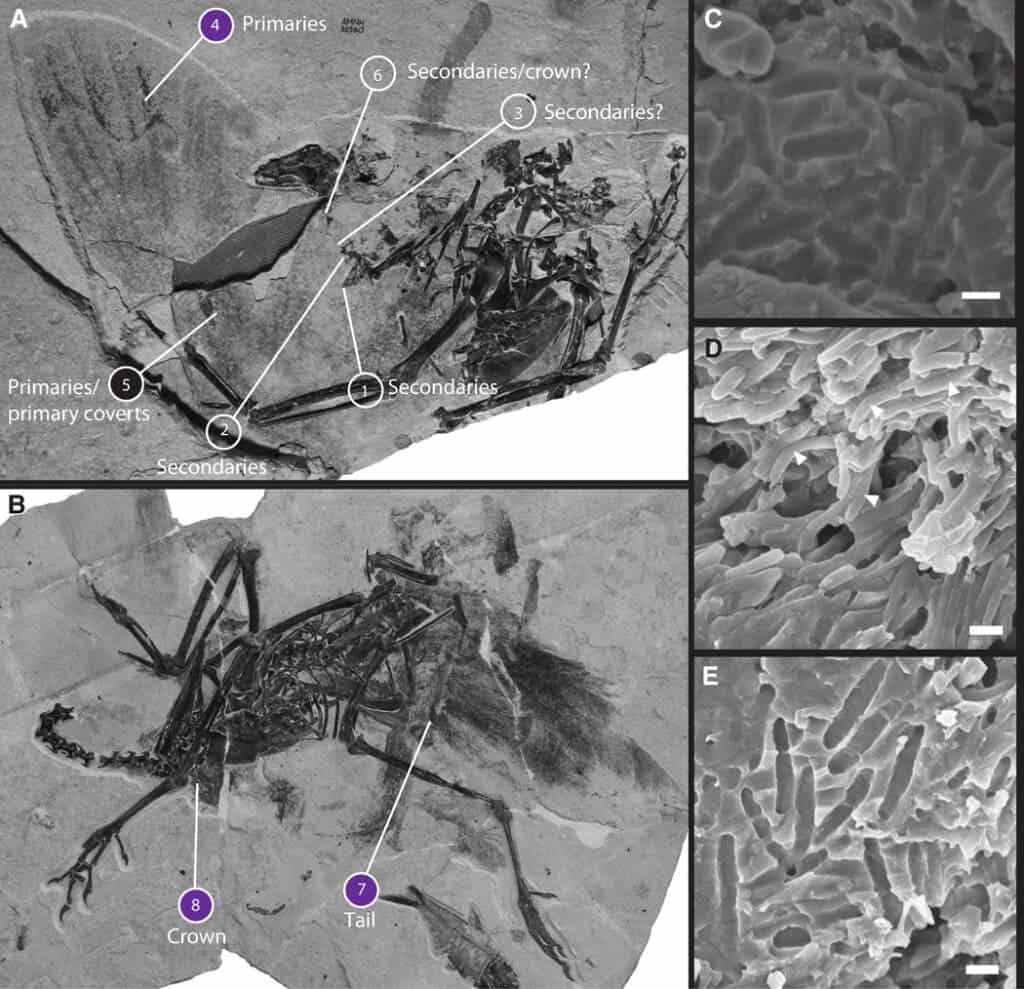New research is helping scientists understand what ancient feathers look like — and why cassowaries are so shiny.
Cassowaries are flightless, blue-headed birds, with distinctive feet that are designed to run, not perch. Along with emus, ostriches, and kiwi birds (to whom they’re related) cassowaries are part of a lineage (the paleognath family) that split off from more ‘normal’ birds like chickens, ducks, and songbirds 100 million years ago. And, while we do know that the songbird family produces its iridescent colors through the physical structure of their feathers, we didn’t know how the cassowaries got their shine.

Panels on the right show fossil melanosomes similar to black (sample 5, C) and iridescent melanosomes in livingbirds (samples 7 and 8 / D and E).
Image credits Chad M. Eliason and Julia A. Clarke2, (2020), Science.
But two fossils described in a new study in the journal Science Advances helps answer that question, while also telling us of how birds used to look 52 million years ago.
Old feathers
“A lot of times we overlook these weird flightless birds. When we’re thinking about what early birds looked like, it’s important to study both of these two sister lineages that would have branched from a common ancestor 80 million or so years ago,” says Chad Eliason, a staff scientist at the Field Museum and the paper’s first author.
Humans and other mammals create color in their skin or hair/fur through the use of pigments, mostly melanin. Birds and insects, however, also use the microscopic structure of their tissues to produce some of their colorations, such as the dazzling iridescent, glossy, or rainbow effects on their feathers and wings.
The cellular constructs that carry pigment are called melanosomes, and different shapes or arrays of melanosomes are used to produce the range of colors we see in nature. Birds’ feathers use keratin in a similar way, altering its microscopic structure to change the way it reflects light (and thus the color we perceive them to be). Their structure also creates the perception of texture (such as matte or glossy) through the way they reflect light.

Image credits Chad M. Eliason and Julia A. Clarke2, (2020), Science.
But these color-creating structures haven’t been found in fossilized paleognath feathers up to now. The team, who has a background in structural color analysis of birds and dinosaurs, found that cassowary feathers also produce structural colors, but by using a different approach than modern birds. Instead of having these structures in their barbules (tiny structures that cover the feathers), they concentrate them in the rachis, the middle trunk of the feather. Their blue heads are also a product of structural coloring, the team explains.
The team then looked at a 52-million-year-old relative of the cassowary, known as the Claxavis bird. It lived in today’s Wyoming and is known from some exceptionally well-preserved fossils that include feather imprints, making it ideal for this study.
“You can look at a fossil slab and see an outline of where their feathers were, because you kind of see the black stain of melanin that’s left over, even after 50 million years or so,” explains Eliason. “We peeled off little flakes of the fossil from the dark spots of melanin, and then we used scanning electron microscopes to look for remnants of preserved melanosomes.”
The melanosomes in the fossilized barbules were long and thin, having the rough shape of green beans, which the team found is associated with iridescence in modern birds. The team says this is strong evidence in favor of ancient paleognath feathers exhibiting structural color. Furthermore, this study also provides the first evidence of structural color in the feathers of paleognaths, helping us understand how cassowaries got so shiny.
Despite this, the team doesn’t know why the two bird families evolved different mechanisms for such coloration. Eliason believes that flightlessness allowed these birds more room to experiment with their feathers, as they didn’t need to keep them aerodynamic.
“Needing to be able to fly is a very strong stabilizing force on wing shape,” says Eliason. “Losing that constraint, that need to fly, might result in new feather morphologies that produce gloss in a way that a flying bird might not.”
“[The findings] give us a glimpse into the time when dinosaurs were going extinct and the birds were rising,” he adds. “Studying these paleognaths gives us a better understanding of what was happening there because you can’t just study neognaths (modern birds); you need to study both sister clades to understand their ancestors.”
The paper “Cassowary gloss and a novel form of structural color in birds” has been published in the journal Science Advances.


